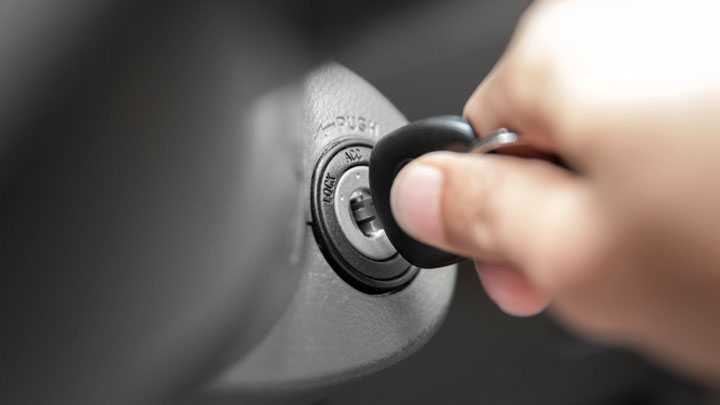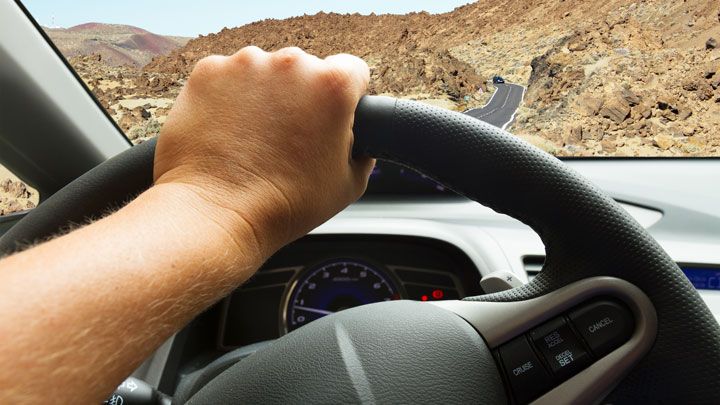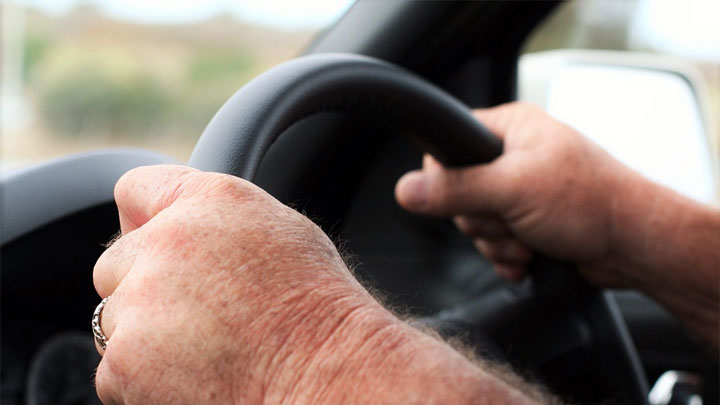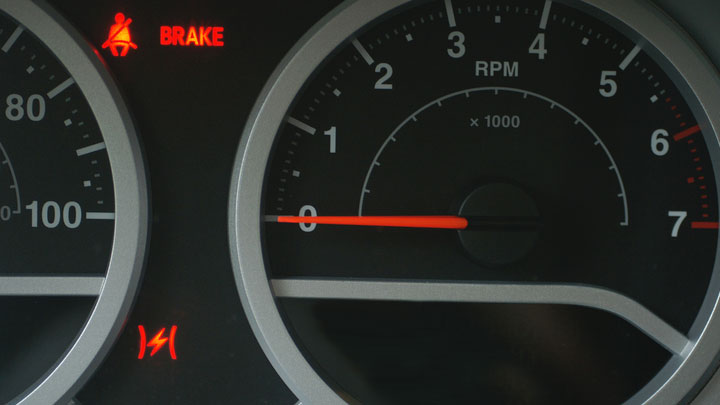Last Updated on October 26, 2021
For most motorists, few things could be more terrifying than having the steering lock up while driving. With little or no warning you suddenly cannot control your car. It’s fortunate that automobile steering systems are designed to greatly minimize the occurrence of this heart-pounding event.
In this article we will discuss two modes of steering failure. Failure where the steering effort suddenly becomes very difficult. And failure where the wheel cannot be turned in either direction at all.
Each type of failure can result in a severe accident with potential for loss of life. First, let’s discuss some related steering technology.
Related: Brakes Locked Up While Driving? (Causes and What to Do)
Power Steering Systems
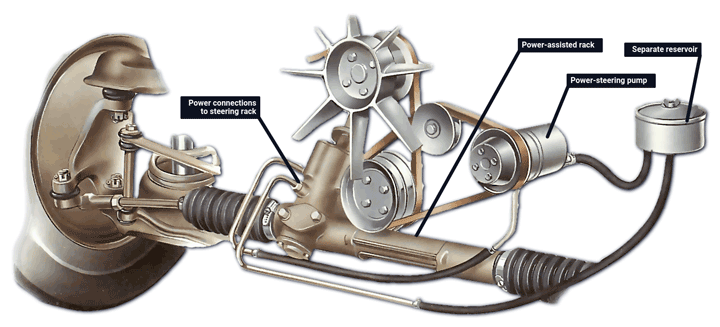
All passenger vehicles including pickup trucks today are equipped with power steering. Invisible to the driver, this type of system reduces steering effort enabling heavy vehicles to be turned with relative ease. Two types of power steering systems are currently in use.
Hydraulic
Present in predominantly older cars, the first system we’ll discuss uses an engine driven pump. This pump is powered by one of the accessory belts typically on the front of the engine.
It includes a reservoir for the necessary hydraulic fluid (oil). The oil level in this reservoir must be checked periodically. When the engine is running this fluid is pumped via flexible hoses to a mechanism called the steering rack.
The steering rack translates the driver’s turning of the steering wheel into mechanical motion that positions the direction of the front wheels. The steering wheel has a shaft (the steering column) connected to the rack. The rack has steel arms connected to the front suspension, these imparting course control for the car.
Electric
The second type of power steering system is electrically operated. This system is integral to the steering rack and assists steering motions to the front suspension similar to the belt driven pump system. It has far fewer components and requires no maintenance throughout the life of the car.
In a sense, these power steering systems intervene between your hands on the wheel and the direction your car takes. For this reason, power steering problems, though rare, can cause steering wheel lockup. More on this in a moment.
Related: Hydraulic vs Electric Power Steering
Steering System Theft Prevention Systems
No discussion of steering wheel lockup would be complete without a brief discussion of steering system theft prevention systems.
In the late sixties automobile manufacturers began installing steering wheel lock devices on their cars. When you bought the car, it included such a system; it was not an option. The evidence of this mechanism was the keyed ignition switch relocated to the steering column from its former home in the dash. Some found this new location to be a bit inconvenient.
When the engine is turned off and the key is removed from the ignition switch, the lock mechanism automatically inserts a hardened steel pin into a detent in the steering column. This pin prevents the wheel from being turned until the key is reinserted into the ignition switch and ignition turned on.
On some designs the wheel had to be turned left or right 30 to 45 degrees to engage the lock. This arrangement could be a startling surprise to any potential thief hot wiring your car. He’d get down the road, attempt a turn, and the wheel would lock no doubt suddenly terminating the theft and possibly wrecking your vehicle.
Column-mounted ignition switches and associated steering wheel locks disappeared from most cars around 2007. In-dash ignition switches returned and keyless entry push button start systems began to appear on automobiles.
But for some cars, locking steering wheels still remain part of the anti-theft features.
See Also: Common Engine Immobilizer Problems
Power Steering System Failures and Steering Lockup
Power steering systems are remarkably trouble-free. But a failure can cause a sudden significant increase in steering effort. This can be especially troublesome at very slow speeds or while braking.
Almost any driver, surprised by this increased stiffness of the wheel movements could quickly lose control.
Imagine you are turning a sharp corner in heavy traffic and suddenly the steering effort skyrockets. With traffic flowing around you, it might be impossible to quickly regain control of the car. An unfortunate collision could result.
Causes of Power Steering Failure
Several events can cause the power steering to not work. These four failure modes apply to systems that use an engine driven pump.
- Power steering pump belt failure. If the belt driving the pump breaks or begins slipping, the pump shaft will not turn and steering effort will suddenly increase.
- Power steering hydraulic hose rupture. This will cause a rapid loss of fluid and an attendant increase in steering effort.
- Power steering fluid level too low. Fluid level dropping below a critical point can cause the pump to stop doing its job. An increase in steering effort will result.
- Power steering pump seizure (sudden stoppage). Caused by fluid contamination or internal failure, this will also result in a sudden increase in steering effort.
Electrically driven power steering systems have fewer hydraulic system failure modes that could cause steering issues. The following problems, however, could result in steering wheel lockup with these systems:
- Electrical power failure to the power steering. A chafing or broken power wire could interrupt power steering operation. Steering effort will suddenly increase.
- Internal failure of the integrated hydraulic system in the steering rack. Steering effort will suddenly increase.
Signs of Impending Steering Wheel Lockup
For pump type systems, several things may give you warning of impending steering wheel lockup.
- Belt slippage can cause an instrument panel warning light to come on if the power steering belt also drives the alternator.
- Belt slippage may instantly message you by squealing (or chirping) when you start the engine or when you turn the steering wheel.
- Hydraulic hose failure can be preceded by leakage. If you notice drops of red or brown fluid in your parking location, it could be leakage from the rack and pinion or a failing hose. Or the pump itself could be leaking. Also, finding low power steering fluid level in the pump reservoir could be a warning of fluid leakage problems.
- With age, surface cracks in hoses, especially at or near metal fittings, can also be a warning of impending rupture.
- An aging pump that is near the point of seizing may overload the drive belt and cause it to squeal. If the belt is tightened to correct this slippage, but it still squeals, complete pump failure may soon follow.
It’s a simple step that can add years of life to your power steering system. Cost for this service is in the $75 - $100 range.
See Also: Power Steering Repair Costs
Steering Rack Mechanical Failures and Steering Lockup
Moving beyond power steering related failures, the steering rack itself can in time become worn. Such wear can produce metallic debris on the metal rack which will hinder the rotation of the associated pinion gear.
The result will be a noticeably increased resistance to turning. This condition must be corrected in order to allay the risk of a complete lockup of the steering wheel at some moment in the future.
What to Do in Case of Power Steering Failure
Whether caused by power steering problems or a rack mechanical issue, such a failure will make turning the steering wheel very difficult. But it can be turned, and if you react quickly an accident can be avoided.
So, the steering suddenly becomes very stiff. What should you do?
- Place both hands firmly on the wheel. Though it takes greater effort you can still control the car.
- Steer the car to the shoulder and stop. Hit the emergency flasher button. Adrenalin may be pumping so calm yourself.
- Call for help. If in a relatively safe location, call for a tow truck to get it to a repair shop. If in a dangerous situation, dialing 911 will bring a police cruiser. On a freeway shoulder having a police cruiser stopped behind you with lights flashing adds security to your situation.
Note: You may think, “Hey, I can drive home; it just steers hard”. Steering hard will make quick reactions to emergency situations difficult. Calling for a tow is really the safest step to take.
What to Do in Case of Complete Steering Wheel Lockup
Because steering column locking systems can fail, such systems can inadvertently cause instant lockup of the steering although it’s extremely rare. For such failures, it will suddenly become impossible to steer the car.
The steering may lock while driving straight ahead or during a turn. This depends on the design of the locking feature on your car’s steering column.
Should this happen, follow these steps:
- Immediately get the car stopped. You may have to stop in a traffic lane, so immediately turn on the emergency flashers.
- Don’t panic. If you cannot exit safely to the shoulder of the highway, remain in the car and dial 911. Explain your situation and location to the dispatcher and request immediate emergency help. Keep seat belts on for maximum protection should your car get struck by another vehicle.
- If safe, exit the vehicle. If oncoming traffic completely clears, exit the car and quickly move to the nearest shoulder. Exercise extreme caution especially if you have children on board.
Let’s hope you never experience steering wheel lockup while driving your car.


